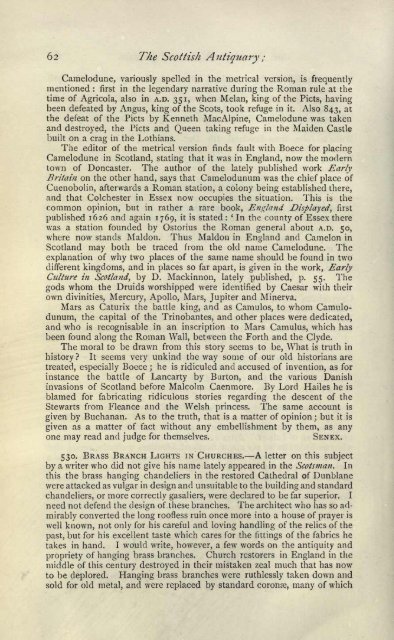Create successful ePaper yourself
Turn your PDF publications into a flip-book with our unique Google optimized e-Paper software.
62 The Scottish Antiquary ;<br />
Camelodune, variously spelled in the metrical version, is frequently<br />
mentioned : first in the legendary narrative during the Roman rule at the<br />
time of Agricola, also in A.D. 351, when Melan, king of the Picts, having<br />
been defeated by Angus, king of the Scots, <strong>to</strong>ok refuge in it. Also 843, at<br />
the defeat of the Picts by Kenneth MacAlpine, Camelodune was taken<br />
and destroyed, the Picts and Queen taking refuge in the Maiden Castle<br />
built on a crag in the Lothians.<br />
The edi<strong>to</strong>r of the metrical version finds fault with Boece for placing<br />
Camelodune in <strong>Scotland</strong>, stating that it was in England, now the modern<br />
<strong>to</strong>wn of Doncaster. The author of the lately published work Early<br />
Britain on the other hand, says that Camelodunum was the chief place of<br />
Cuenobolin, afterwards a Roman station, a colony being established there,<br />
and that Colchester in Essex now occupies the situation. This is the<br />
common opinion, but in rather a rare book, England Displayed, first<br />
published 1626 and '<br />
again 1769, it is stated : In the county of Essex there<br />
was a station founded by Os<strong>to</strong>rius the Roman general about A.D. 50,<br />
where now stands Maldon. Thus Maldon in England and Camelon in<br />
<strong>Scotland</strong> may both be traced from the old name Camelodune. The<br />
explanation of why two places of the same name should be found in two<br />
different kingdoms, and in places so far apart, is given in the work, Early<br />
Culture in <strong>Scotland</strong>, by D. Mackinnon, lately published, p. 55. The<br />
gods whom the Druids worshipped were identified by Caesar with their<br />
own divinities, Mercury, Apollo, Mars, Jupiter and Minerva.<br />
Mars as Caturix the battle king, and as Camulos, <strong>to</strong> whom Camulodunum,<br />
the capital of the Trinobantes, and other places were dedicated,<br />
and who is recognisable in an inscription <strong>to</strong> Mars Camulus, which has<br />
been found along the Roman Wall, between the Forth and the Clyde.<br />
The moral <strong>to</strong> be drawn from this s<strong>to</strong>ry seems <strong>to</strong> be, What is truth in<br />
his<strong>to</strong>ry ? It seems very unkind the way some of our old his<strong>to</strong>rians are<br />
treated, especially Boece he is ; ridiculed and accused of invention, as for<br />
instance the battle of Lancarty by Bur<strong>to</strong>n, and the various Danish<br />
invasions of <strong>Scotland</strong> before Malcolm Caenmore. By Lord Hailes he is<br />
blamed for fabricating ridiculous s<strong>to</strong>ries regarding the descent of the<br />
Stewarts from Fleance and the Welsh princess. The same account is<br />
given by Buchanan. As <strong>to</strong> the truth, that is a matter of opinion but it is<br />
;<br />
given as a matter of fact without any embellishment by them, as any<br />
one may read and judge for themselves. SENEX.<br />
530. BRASS BRANCH LIGHTS IN CHURCHES. A letter on this subject<br />
by a writer who did not give his name lately appeared in the Scotsman. In<br />
this the brass hanging chandeliers in the res<strong>to</strong>red Cathedral of Dunblane<br />
were attacked as vulgar in design and unsuitable <strong>to</strong> the building and standard<br />
chandeliers, or more correctly gasaliers, were declared <strong>to</strong> be far superior. I<br />
need not defend the design of these branches. The architect who has so ad-<br />
mirably converted the long roofless ruin once more in<strong>to</strong> a house of prayer is<br />
well known, not only for his careful and loving handling of the relics of the<br />
past, but for his excellent taste which cares for the fittings of the fabrics he<br />
takes in hand. I would write, however, a few words on the antiquity and<br />
propriety of hanging brass branches. Church res<strong>to</strong>rers in England in the<br />
middle of this century destroyed in their mistaken zeal much that has now<br />
<strong>to</strong> be deplored. Hanging brass branches were ruthlessly taken down and<br />
sold for old metal, and were replaced by standard coronae, many of which

















